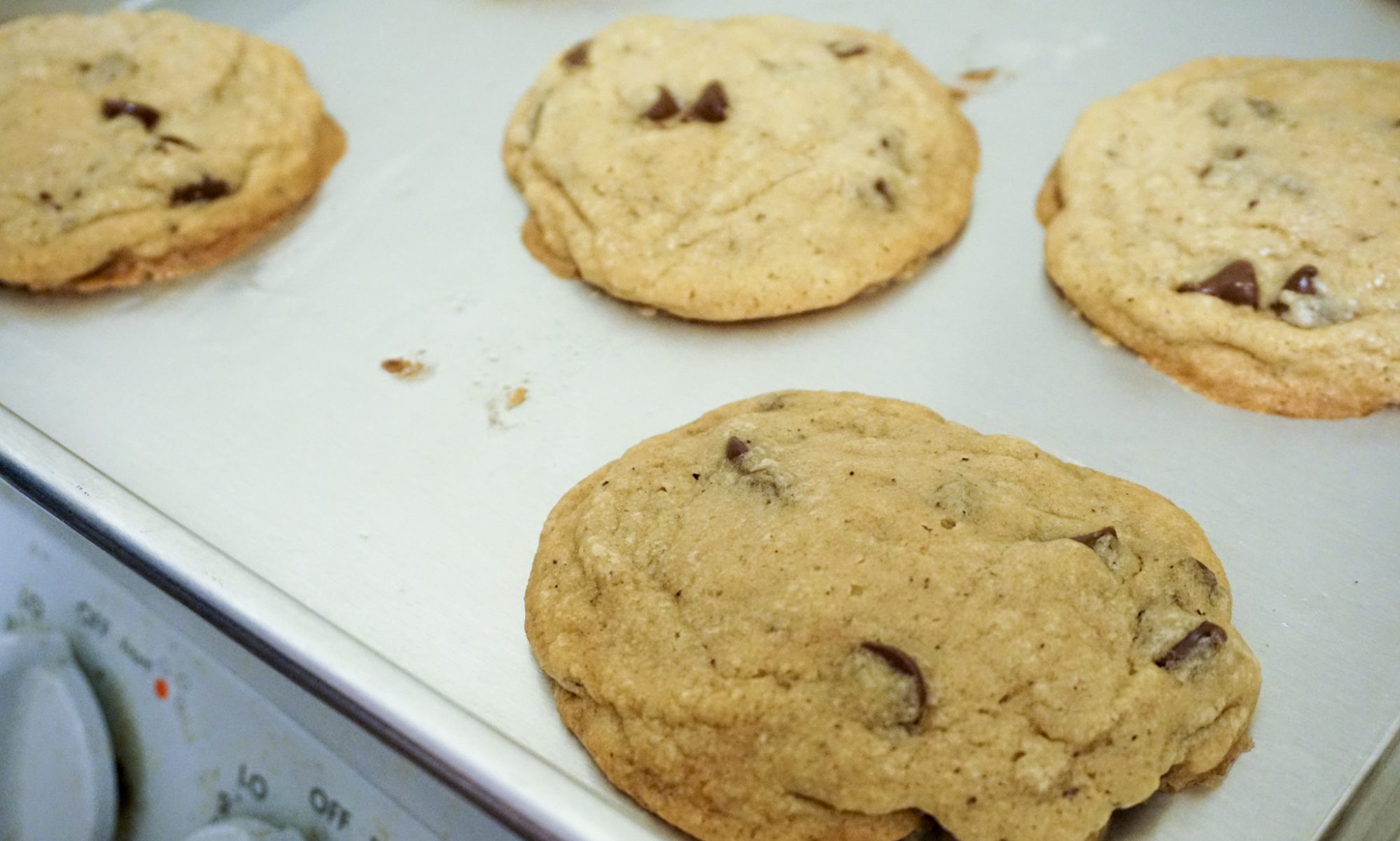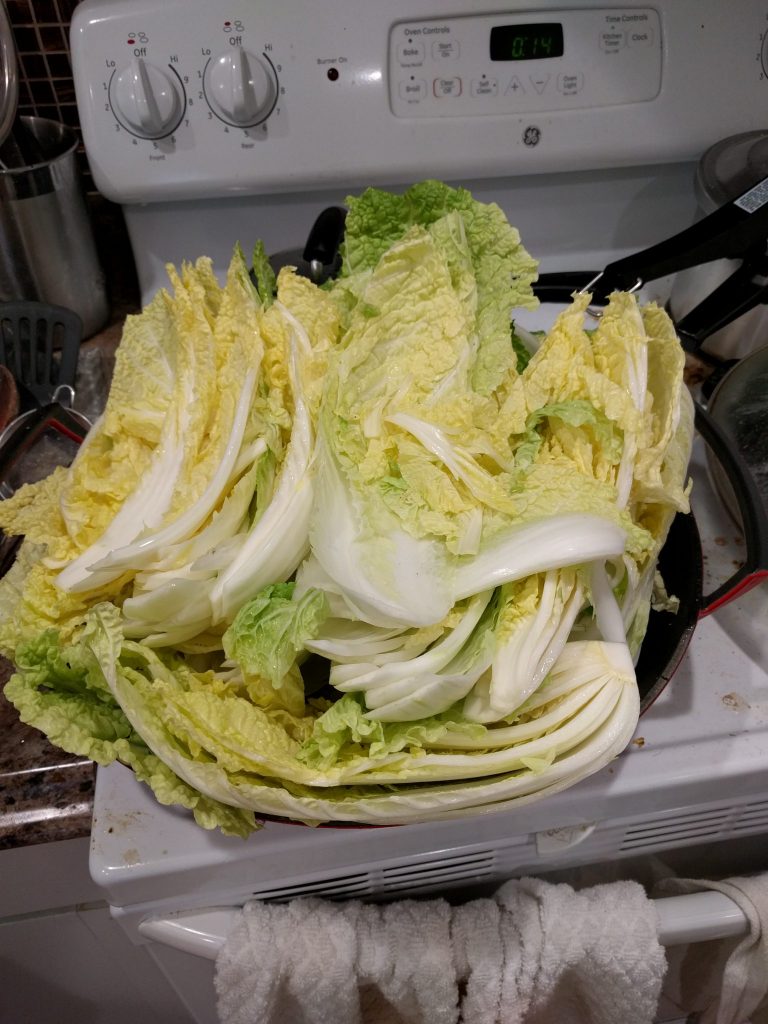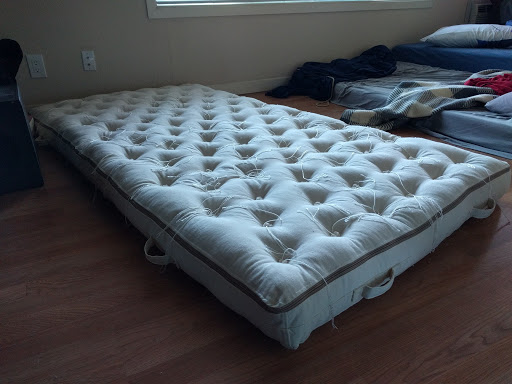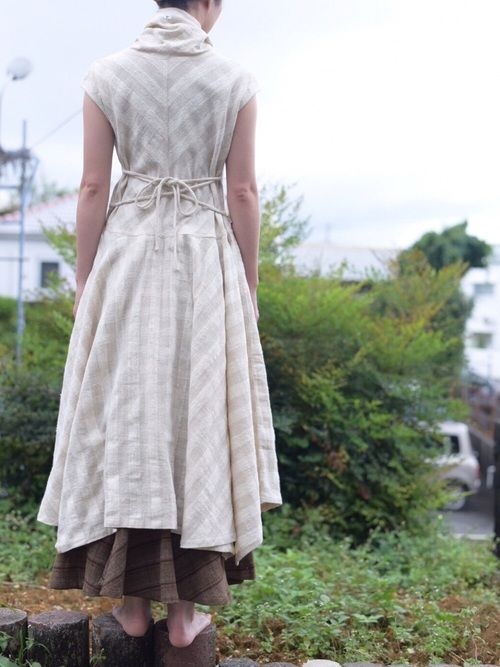We’ve started trying to make something resembling sake. We found a sake recipe online, but it seemed really hard so I just mixed random stuff together instead.


Food, sustainablity, and some other stuff
We’ve started trying to make something resembling sake. We found a sake recipe online, but it seemed really hard so I just mixed random stuff together instead.

J and I were running low on kimchi. The last batch was from 3 or 4 months ago, so we go through about 1 quart per month. College friend S was interested, so we all got together to make kimchi!
We used Maangchi’s recipe, omitting the minari (dropwort) and the Asian chives, and substituting bonito flakes for the brined shrimp. This time, we also decreased the red pepper flakes to 1 cup. We didn’t have enough Korean red pepper flakes, so I substituted cayenne pepper powder for the remainder needed.

In addition to Napa cabbage (tongbaechu) kimchi, we tried making green onion (pa) kimchi. J really likes green onions 🙂
As usual, the kimchi turned out deliciously. It is much more edible this time around, thanks to halving the amount of red pepper in the recipe! The key to the flavor is the fish. Without it, the kimchi tastes bland (not enough umami); if you get it wrong, it tastes horrible. There was a memorable batch of kimchi several years ago where I used Thai shrimp paste that unfortunately smelled like rubber…


Out of curiosity, I looked up what bacteria are present in kimchi.
The picture [the experiment] paint[s] is that the microbial population changes fairly radically over time. At first, the cabbage, which was soaked in brine, drained, and mixed with a variety of seasonings, was populated mostly by unidentified bacteria and ones from the Deferribacterales group, whose representatives have cropped up in oilfields and in the guts of deep-sea shrimp. These bacteria may have been on the cabbage to begin with, rather than having anything to do with the fermentation, because as the days passed, and the oxygen ran out, others began to take over.
By the seventh day, DNA from the Leuconostoc group, which converts sugars into lactic acid and are behind the fermentation of kefir, a fermented milk drink, and sourdough bread, was on the rise. By day 13, members of the Lactobacillus and Weisellagroups had joined in. Like Leuconostoc, Lactobacillus andWeisella produce lactic acid from sugar, and they’re also part of the team behind cheese, kefir, pickles, and other fermented products. Together the three groups dominated the kimchi for the rest of the experiment.
From BBC Future.
And I discovered that there’s a fermentation subreddit for all your fermentation needs! (The top post at the moment is titled “The number one mistake fermentation newbies make is paranoia“!)
After sleeping on my mattress for a few nights on and off, I’m disappointed to report that it gives me allergies ): I know for sure that it’s not because it’s made of wool. My pillow is also stuffed with wool, and I’ve never had trouble with it. Instead, the problem seems to be the quality of the wool…
After lacing, I cut the string so that every desired tuft location had two string ends on the top of the mattress. I loosely tied the ends with a special tufting knot, as described in How to make a cotton mattress.

Before tightening the string fully, I placed rolled up pieces of cotton sliver on the top and bottom of the mattress underneath the string. This helps prevent the string from ripping through the fabric of the ticking (mattress case).
This part was really hard. You have to tighten the string a lot, and each knot has to be tightened the same amount. Otherwise your mattress will be lumpy and uneven. It took me several days to finish this part. My fingers were so sore!!

The final mattress is fine. It’s not amazing, but it’s definitely sufficient. It’s pretty firm, as expected. Unfortunately, there’s very little spring. Maybe I should have added a thin latex core. I hear latex is excessively springy, enough that it’s not usually used alone.
I haven’t slept on the mattress yet, so I’ll report back once the two of us are more familiar! 😀

After stuffing the mattress, you need to lace and tuft it. In a mattress, tufting compresses the stuffing to give it a specific feel (for wool, springier and firmer). It also helps hold the stuffing in place. If a wool mattress isn’t tufted, then as you sleep on it, the wool will tend to shift to the edges of the mattress, leaving you in a ditch. And you need to lace before you tuft.
Why did I decide to make a mattress? Well, I started researching and kinda went down the rabbit hole…
I’d had my eye on Holy Lamb Organics wool mattress for a long time. It seems like a great company. They use organic cotton and organic/sustainably sourced wool. But the mattresses only come in 4″ and 5″ thicknesses (seemed a bit thin for my then-tastes) and are fairly expensive ($1300 or $1600 for twin XL, depending on thickness).
So I started doing more research into sustainable and some conventional mattress options.
I found several other (seemingly lesser) brands, and then I came across DIY Natural Bedding. This is a company that supplies the parts for people to assemble their own mattresses and other bedding, like comforters and pillows (!!!!). So cool!! And almost all of the parts are sustainable. For example, all their fabric is organic cotton, grown and milled in the US. The wool is basically organic (not certified, but still sustainable).Their latex is organic. They also do custom work, e.g. for furniture.
The DIY Natural Bedding website is rife with inspiration. I figured if I were going to assemble the mattress myself, I might as well go all the way and make the parts myself too. You know I love crafts!
I decided to make a wool mattress, as opposed to latex, for a few reasons. Wool can be raised domestically; latex comes from rubber trees, which only grow in tropical regions. The latex from DIY Natural Bedding, in particular, is from Sri Lanka, which is far away. Latex mattresses last a long time (30 years!), but wool lasts even longer (100 years!!!!, with some maintenance). If I ever decide to dissemble my mattress, it would be easier to repurpose wool than to repurpose a rectangular chunk of latex foam. I am absolutely certain that wool is biodegradable; I’m not sure about latex.
Lastly, wool mattresses are traditional. I know, I know, not a great reason. But I am solidly part of the modern reskilling movement, and think that it’s important to preserve traditional crafts. How to make a cotton mattress is an old document I heavily relied on for construction ideas.
Here’s a cute story about how long wool mattresses last. Here’s another cute story.
I worked on my wool mattress last Saturday. I was just stuffing it (and worked all day!), but got barely halfway done. I can’t imagine making wool mattresses for a living…
It’s been taking up so much room on the floor. And the wool I’m using is really dirty, so there’s dirt and wool everywhere. The apartment is going to get a thorough cleaning once I’m completely done with the mattress. There’s even wool fluff under the sofa.
Despite all the work, I’m glad I didn’t buy a commercial wool mattress. Mine is almost certainly going to be higher quality than most of those available in the US. And now I know how to make a mattress!
After the Mahouka movie and my thrift store finds, we browsed the Japantown mall. In the atrium area, there was an amazing Japanese clothing brand~ They were having an exhibition to advertise and sell their products, and I totally got sucked in. Everything was amazing!!! I could tell even from a distance that it was my type of clothing, from the colors to the cut.
The company is called Usaato, a contraction of Usaburo Sato, the designer’s name. It’s a pun: “usaato” also means “rabbit” (although it’s a less common word than “usagi”), which they use in their logo. Here’s their Facebook page (in Japanese) and their USA page, which still has quite a bit of Japanese.

Continue reading “Awesome Japanese, ethical, slow fashion clothing brand!!”
On Saturday, I went to sewing hour at my local library. (There are sewing machines available for public use!) There are always more projects to work on, and items to repair!
I’ve been modifying a shirt I made a few months ago. The collar was a little short, and I had forgotten to trim the seam allowance to make room for the collar buttonhole. I’ve been reading Shirtmaking by David Coffin, which spurred me to try to make improvements.
J and I went to the county fair last weekend. J already wrote his review.
I was mostly interested in going for the crafts and animals. Of course I’ve gone to county fairs before when I was growing up, but I haven’t been since I’ve gotten more into crafts and heritage stuff (which includes livestock breeds!).
There was the requisite quilt competition, along with homemade clothing (not much), and crocheted and knitted items. I was excited to see a group of spinners (the Elkus Ranch Spinners) and a sustainable living section!